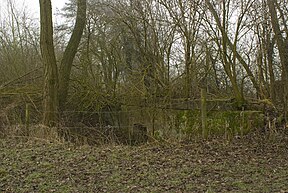Buckingham Arm
| Buckingham Canal (former Buckingham Arm) | |
|---|---|

An aqueduct carried the canal over a small stream to the east of Foscote Reservoir
|
|
| Specifications | |
| Locks | 2 |
| Status | Restoration project |
| History | |
| Date of act | 1793, 1794 |
| Date of first use | 1800 |
| Date completed | 1801 |
| Date closed | 1932 |
| Geography | |
| Start point | Cosgrove |
| End point | Buckingham |
| Connects to | Grand Union Canal |
The Buckingham Arm is a canal that once ran from Cosgrove, Northamptonshire to Buckingham (in England). It was built as an arm of the Grand Junction Canal, in two separate phases, opening in 1800 and 1801. It was disused from 1932, but was not finally abandoned until 1964. It is now the subject of a restoration programme with the Buckingham end holding water for a length of nearly 400m.
On 30 April 1793, the Grand Junction Canal was authorised by an Act of Parliament, and the act made provision for an arm from the main line to Old Stratford, ending at the former Roman road of Watling Street, which was a major communications route. The continuation to Buckingham was surveyed in 1793, and included in another Act of Parliament, passed in September 1794, which authorised the construction of the Aylesbury, Buckingham and Wendover arms.
The initial section to Old Stratford was to be constructed as a broad canal, capable of use by boats which were 14 feet (4.3 m) wide. The Grand Junction Canal had to cross the River Great Ouse at Wolverton, and the original plan was to construct a crossing on the level, with a flight of locks down one side of the valley and another up the other side. The Old Stratford branch would have had a junction with the main line at the lowest level, and followed the course of the Great Ouse valley. From Old Stratford, the canal was to continue as a 7-foot (2.1 m) narrow canal, which would have joined the river at Passenham, effectively becoming a navigation, as a number of locks would have been needed along the course of the river. The plans were changed when it was decided to construct a high level crossing of the Great Ouse, ruling out the possibility of a junction, and so the arm left the main line just above Cosgrove lock, following the north side of the Great Ouse valley, and resulted in a canal which was on one level for most of its length, with just two locks as it approached Buckingham.
The Grand Junction Canal, which included the two flights of locks to cross the River Great Ouse, opened in August 1800, and the Old Stratford arm followed six weeks later, in September. The Buckingham branch progressed quickly and was built in 8 months. A formal opening occurred on 1 May 1801, with celebrations as Buckingham. The canal was supplied with water by a feeder from the Great Ouse in Buckingham. The lock flights on the main line were replaced by two embankments and an aqueduct in 1805, but there were problems with the aqueduct, and it was replaced with an iron trough in 1811.
...
Wikipedia
